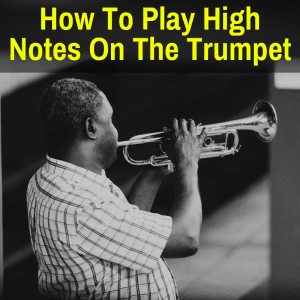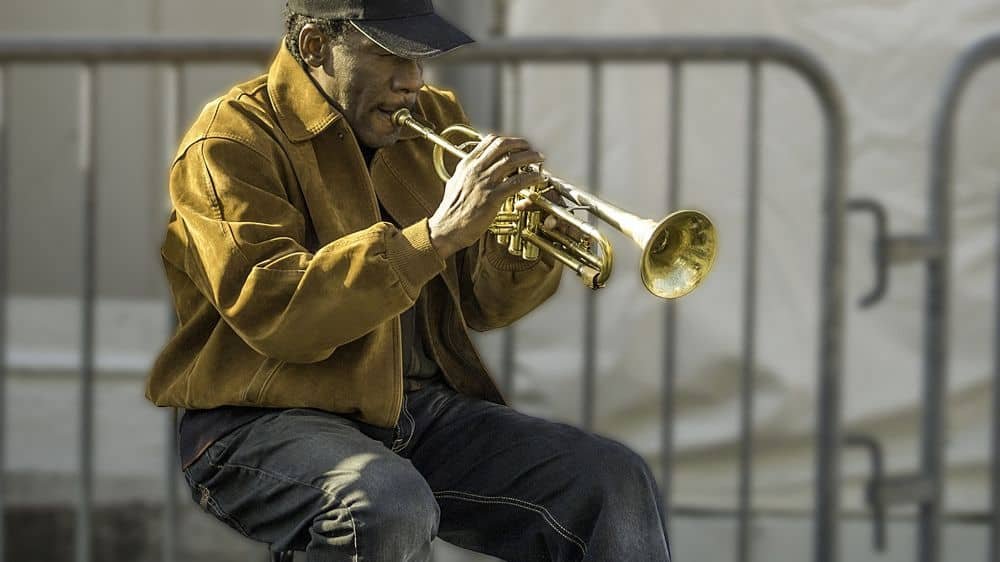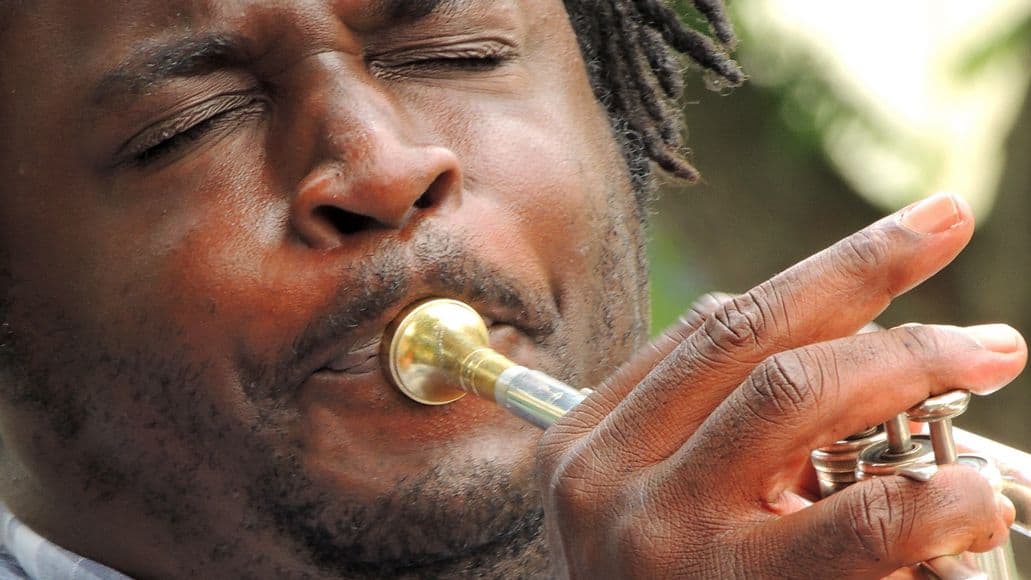 Playing high notes is hard.
Playing high notes is hard.
Hitting those notes is a major concern of every trumpet player.
They all want to be able to hit those high notes, but it is one of the more difficult skills to master.
There is a whole industry of products and apps designed to teach this specific skill.
None of that is necessary though.
I’ve got some simple tips in this article that will have you hitting those high notes with ease in no time.
We’ll use a combination of mindset and exercises to get there. But first let’s make sure we know why we want to be able to play higher notes.
Table of Contents
Trumpet High Notes: Why Are They Important?
Part of it is status. Playing high notes denotes experience and a higher skill level. Trumpeters like to show off and competition among them can be fierce, whether they play the regular trumpet or a mini pocket trumpet.
Everyone wants to be able to stand out from the crowd and every beginner wants to someday be known as one of the best trumpeters ever. Being able to play notes most can’t, lends one a bit of status and mystique.
How To Play High Notes On The Trumpet
First, Are There Really High Notes?
A big reason most trumpet players find it difficult to play high notes is that they were told it is extremely difficult to play those notes. So when they pick up their instrument, they have already made up their mind that they can’t play the high notes.
You need to change that mindset and here’s how.
I’m sure you can agree that C is not a high note. That means C# isn’t a high note either, since it is only one step higher. And D is also not a high note, since it is only half a step higher than C#. That means Eb can’t be a high note either and so on.
You can continue as long as you like. The end result is this: there are no high notes, just notes that are one little step higher than the previous. And you can go up one little step, can’t you?
The secret is that, if you can play C, then you can play C#. And if you can play C#, you can play D as well. And from D you can play Eb and every other note.
Learning To Play Higher Notes
The first stage to playing higher notes is to start playing C. This note lies in the middle of the trumpet range. From C, move to C#, then on to D and on to Eb, etc.
Below is a simple way to build a consistent approach to mastering the whole range of the trumpet. It shows insteps for how to easily play a double C.
To begin, start on the low F#. Following a specific pattern, slur out 5 key notes 1-2-3-4-5-4-3-2-1-2-3-4-5. Do the same thing for G, Ab, A, Bb, B and C.
Next, do the same thing with the pattern 1 – 2 – 3 for F#, 1 – 3 for G, 2 – 3 for Ab, 1 – 2 for A, 1 for Bb, 2 for B, and 0 for C. This allows you to successfully connect all the breaks in the overtone.
The main idea here remains the same. Take easy breaths while blowing the entire time and aim for sound consistency. Simply continue playing while keeping the same idea in mind and move up to the upper octaves.
It is important to do this exercise every day. Continue practicing and with time, you will be able to play the whole range.
Helpful Tips For Playing The High Notes
- Don’t increase the pressure on your lips trying to hit the high notes; keep it at a minimum and play naturally.
- Rest as often as you play, preferably after every 5 minutes of playing higher octaves.
- Position your body well; don’t slouch and stand (or sit) up straight while maintaining a good posture and a relaxed hold.
- Don’t puff your cheeks in an attempt to force out higher notes; if you find yourself dong this, try squeezing your cheeks while playing, so they will stay that way.
- Look in the mirror as you practice, so you can monitor where you are placing your lips to get the right notes, as well as your posture.
- When playing, lift your tongue to enable air pressure buildup and move faster, to create high pitches.
- Don’t just limit your practice sessions to higher octaves; also practice arpeggios, chromatics and cold attacks on the same notes.
- Always take a deep breath and fill your lungs with enough air, before playing any note; remember to keep your posture straight to improve your breathing.
- Breathe from your stomach and not from your chest; this helps increase the air pressure, making it easier to hit higher notes.
The following video might help you with the high notes, too.
How To Play Higher Notes On Trumpet: Related Questions
Next, we will answer some common related questions. If you have additional questions about how to play high notes on the trumpet, please ask them in the comments below.
What Trumpet Mouthpiece Is Best For High Notes?
To be honest, there are no special mouthpieces for high notes. The main thing you need to look out for is to get one that is the correct size, but that is true for playing any kind of note, not just the high ones.
This article on the best trumpet mouthpieces can help you find the right mouthpiece for you.
What is the highest note a trumpet can play?
Assuming you are using a regular B-flat trumpet, notes up to the highest G are relatively easy to produce. Most fingering tables end at the high C, but the range extends up to F#3 to F#6.
What Is The Range Of A Trumpet?
The range of the Bb trumpet begins at the F#, just below the middle C. It extends for about three octaves, up to the F#3 to F#6 range.
Do Trumpets Come In Different Keys?
Yes, they do. In fact, you can find a trumpet in every possible key, though only 4 are common. The most common one is the Bb trumpet. It is considered the everyday trumpet and is the one used in jazz and big bands.
The C trumpet is also quite common and is the preferred instrument for orchestras, at least in the United States. Eb/D, Eb/E and G/F trumpets are less common, but also used in classical concerti and some some chamber music.
The final commonly seen trumpet is the piccolo, which is usually pitched in Bb/A. It specializes in high-pitched music, like high baroque trumpet parts.
Which Trumpet Players Are Known For Playing High Notes?
There are a number of famous trumpeters who are well-knows for their ability to play high notes. A few of them are Cat Anderson, Dizzy Gillespie, Wayne Bergeron, Thomas Gansch, and Arturo Sandoval.
How To Play High Notes On Trumpet: Final Thoughts
Playing high notes on the trumpet is a challenge, but is very doable. If you’re thinking about extending your range, I would first think about why you are doing so.
If you intend to play pieces that require high notes, then you should definitely work on learning to play higher. But if you are doing it to show off how high you can play, it may not be worth the trouble. You’ll have to think about that for yourself.
Once you’ve decided to take on this challenge, just remember there is no such thing as a high note. They are all just notes.
Take them one step at a time and follow my instructions and tips from above. Continue to practice and before long, you will be able to play any note in the trumpet’s range. Then, you’re ready for the next challenge. Perhaps you might want to learn to use the double tongue technique.


I’m stuck and always play the same crap.
Well that’s your fault.I can a high e and I have played for four months
I stopped playing trumpet 35 years ago and then could consistently hit G above high C (but never higher). Four months ago I started playing again seriously. I’m back to being pretty solid on the G and rock solid on the F. (So, after only four months, I’m not complaining.) However, I can glissando up to the Bb above high C (often, but not consistently, yet). So, why can I glissando up higher than I can play in scales or chromatics and with seemingly less effort? What’s going on? My goal is to get the D above double C to the end that the double C will be solid and effortless. No real interest in going above the double C.
When you are going to play a higher note, lift your tongue up. This causes air pressure to build up and forces the air to move faster, creating high pitches.
Thanks for the tip!